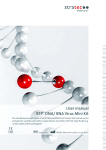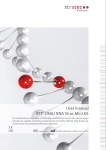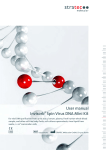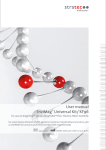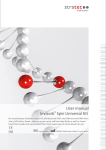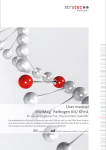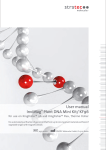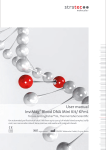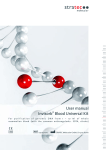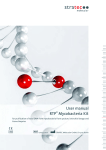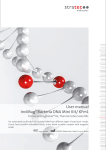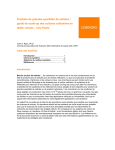Download RTP Pathogen Kit User manual
Transcript
User manual RTP® Pathogen Kit for simultaneous isolation of high quality bacterial and viral DNA as well as viral RNA from human and animal serum and plasma samples, cell-free body fluids, swabs or tissue biopsies IVD REF 1040500x0 STRATEC Molecular GmbH, D-13125 Berlin Instruction for the RTP® Pathogen Kit The RTP® Pathogen Kit is the optimal tool for simultaneous isolation of high quality bacterial and viral DNA as well as viral RNA from human and animal serum and plasma samples, cerebrospinal fluid, cell culture supernatants and other cell free body fluids, like urine as well as from swabs or tissue biopsies for in-vitro-diagnostic purposes using spin-filter format. Fresh or frozen plasma or serum from blood treated with anticoagulants like EDTA or citrate, but not with heparin can be used. The customer convenient well established RTP® technology using prefilled Extraction Tubes simplifies the process handling, reduces the handling steps with infectious material and allows a process monitoring. Due to the high purity, the isolated viral DNA / RNA and bacterial DNA is ready to use for a broad panel of downstream applications or can be stored at –80 °C for subsequent use. The kit is neither validated for the isolation of genomic DNA from stool sample, parasites or the purification of total RNA from clinical samples. IVD Compliance with EU Directive 98/79/EC on in vitro medical devices. Not for in-vitro diagnostic use in countries where the EU Directive 98/79/EC on in vitro medical devices is not recognized. Trademarks: Invisorb®, RTP®, InviMag®, Eppendorf®. Registered marks, trademarks, etc. used in this document, even when not specifically marked as such, are not to be considered unprotected by law. The Invisorb® technology is covered by patents and patent applications: US 6,110363, US 6,043,354, US 6,037,465, EP 0880535, WO 9728171, WO 9534569, EP 0765335, DE 19506887, DE 10041825.2, WO 0034463. Invisorb®, RTP® and InviMag® are registered trademarks of STRATEC Biomedical AG. The PCR process is covered by US Patents 4,683,195, and 4,683,202 and foreign equivalents owned by Hoffmann-La Roche AG. © 2015 STRATEC Molecular, all rights reserved. 1 ® RTP Pathogen Kit 0515 Contents Kit contents of RTP® Pathogen Kit 3 Symbols 4 Storage Quality control and product warranty 4 4 Intended use 5 Product use limitation 5 Safety information Product characteristic of the RTP Pathogen Kit 6 7 Internal control (IC)/ Extraction control 9 Principle 9 Procedure Important notes 9 10 Important points before starting a protocol Important indications 10 10 Yield and quality of pathogen DNA/ RNA Preparing buffers 11 11 Equipment and reagents to be supplied by user 12 Sampling and storage of starting material 12 Volume adjustment of sample material 14 Preparation of starting material 14 Instructions 16 Scheme 17 ® Protocol: Simultaneous isolation of total nucleic acids (DNA and RNA) from all liquid samples Troubleshooting 18 19 General notes on handling DNA 20 General notes on handling RNA 21 Ordering information 22 2 ® RTP Pathogen Kit 0515 Kit contents of RTP® Pathogen Kit Store all kit components at room temperature (RT)! 10 preps 50 preps 250 preps 1040500900 1040500200 1040500300 10 50 5 x 50 15 ml 30 ml 150 ml 5 x 1 ml (ready to use) empty bottle (final volume 30 ml) empty bottle (final volume 120 ml) 15 ml (ready to use) 15 ml (ready to use) 20 ml (final volume 40 ml) 12 ml (final volume 60 ml) 80 ml (final volume 160 ml) 50 ml (final volume 250 ml) 2 x 2 ml 15 ml 60 ml RTA Spin Filter Set 10 50 5 x 50 RTA Receiver Tubes 30 3 x 50 15 x 50 Elution Tube 10 50 5 x 50 Manual 1 1 1 Fill 30 ml 99.7% Isopropanol (molecular biologic grade) into the empty bottle Fill 120 ml 99.7% Isopropanol (molecular biologic grade) into the empty bottle Add 20 ml of 96 – 100 % ethanol to the bottle Wash Buffer R1, mix thoroughly and always keep the bottle firmly closed! Add 80 ml of 96 – 100 % ethanol to the bottle Wash Buffer R1, mix thoroughly and always keep the bottle firmly closed Add 48 ml of 96 – 100 % ethanol to the bottle Wash Buffer R2, mix thoroughly and always keep the bottle firmly closed! Add 200 ml of 96 – 100 % ethanol to the bottle Wash Buffer R2, mix thoroughly and always keep the bottle firmly closed! Catalogue No. Extraction Tube Resuspension Buffer R Binding Solution (fill with 99.7% Isopropanol) Wash Buffer R1 Wash Buffer R2 Elution Buffer R Initial steps 3 ® RTP Pathogen Kit 0515 Symbols Manufacturer Lot number Catalogue number Expiry date Consult operating instructions Temperature limitation Do not reuse Storage All buffers and kit components of the RTP® Pathogen Kit including the Extraction Tube (incl. Lysis Buffer, Proteinase K, Lysozyme, Carrier RNA and Internal Control DNA) should be stored well sealed and dry at room temperature (RT) and are stable for at least 12 months under these conditions. Wash Buffer R1 and R2 charged with ethanol should be appropriately sealed. Before every use make sure that all components have room temperature. If there are any precipitates within the provided solutions solve these precipitates by warming up carefully. Room temperature is defined as range from 15 – 30°C. Quality control and product warranty STRATEC Molecular warrants the correct function of the RTP® Pathogen Kit for applications as described in this manual. Purchaser must determine the suitability of the Product for its particular use. Should any Product fail to perform the applications as described in the manual, STRATEC Molecular will check the lot and if STRATEC Molecular investigates a problem in the lot, STRATEC Molecular will replace the Product free of charge. STRATEC Molecular reserves the right to change, alter, or modify any Product to enhance its performance and design at any time. In accordance with STRATEC Molecular’s ISO 9001-2000 and ISO EN 13485 certified Quality Management System the performance of all components of the RTP® Pathogen Kit have been tested separately against predetermined specifications routinely on lot-to-lot to ensure consistent product quality. If you have any questions or problems regarding any aspects of RTP® Pathogen Kit or other STRATEC Molecular products, please do not hesitate to contact us. A copy of STRATEC Molecular’s terms and conditions can be obtained upon request or are presented at the STRATEC Molecular webpage. For technical support or further information please contact: from Germany +49-(0)30-9489-2901/ 2910 from abroad +49-(0)30-9489-2907 or contact your local distributor. 4 ® RTP Pathogen Kit 0515 Intended use The RTP® Pathogen Kit is the ideal tool for reliable and fast simultaneous isolation of high quality bacterial and viral DNA as well as viral RNA from fresh or frozen human or mammalian serum, plasma, cerebrospinal fluid, cell culture supernatants and other cell free body fluids as well, swabs or tissue biopsies as well as for efficient isolation of high quality high bacterial DNA from bacterial species, tissue samples, urine, paper points, swabs and water using spin-filter format. For reproducible high yields an appropriate sample storage and quick operation under the rules for RNA and DNA operation is essential. The purified viral DNA and/or RNA and bacterial DNA is ready to use for in vitro diagnostic analysis only. The isolation protocols as well as all buffers are optimized to provide high yield and purity of the extracted viral & bacterial nucleic acids. The procedure requires minimal interaction by the user, allowing safe handling of potentially infectious samples. THE PRODUCT IS INDENTED FOR USE BY PROFESSIONAL USERS ONLY, SUCH AS TECHNICIANS, PHYSICIANS AND BIOLOGISTS TRAINED IN MOLECULAR BIOLOGICAL TECHNIQUES. It is designed to be used with any downstream application employing enzymatic amplification or other enzymatic modifications of DNA/ RNA followed by signal detection or amplification. Any diagnostic results generated by using the sample preparation procedure in conjunction with any downstream diagnostic assay should be interpreted with regard to other clinical or laboratory findings. To minimize irregularities in diagnostic results, adequate controls for downstream applications should be used. The kit is in compliance with EU Directive 98/79/EC on in vitro medical devices. But it is not for in-vitro diagnostic use in countries where the EU Directive 98/79/EC on in vitro medical devices is not recognized. Product use limitation The kit is neither validated for the isolation of vertebrate or parasite genomic DNA or total RNA, for the purification of pathogen NA from Heparin, EDTA or Citrate stabilized blood nor for the purification of pathogen NA from Heparin stabilized serum or plasma. The included chemicals are only useable once. Differing of starting material or flow trace may lead to inoperability; therefore neither a warranty nor guarantee in this case will be given, neither implied nor express. The user is responsible to validate the performance of the STRATEC Molecular Product for any particular use. STRATEC Molecular does not provide for validation of performance characteristics of the Product with respect to specific applications. STRATEC Molecular Products may be used e.g.in clinical diagnostic laboratory systems conditioned upon the complete diagnostic system of the laboratory the laboratory has been validated pursuant to CLIA’ 88 regulations in the U.S. or equivalents in other countries. All Products sold by STRATEC Molecular are subject to extensive quality control procedures (according to ISO 9001-2000 and ISO EN 13485) and are warranted to perform as described herein. Any problems, incidents or defects shall be reported to STRATEC Molecular immediately upon detection thereof. The chemicals and the plastic parts are for laboratory use only; they must be stored in the laboratory and must not be used for purposes other than intended. The Product with its contents is unfit for consumption. 5 ® RTP Pathogen Kit 0515 Safety information When and while working with chemicals, always wear a suitable lab coat, disposable gloves, and protective goggles! Avoid skin contact! Adhere to the legal requirements for working with biological material! For more information, please consult the appropriate material safety data sheets (MSDS). These are available online in convenient and compact PDF format at www.stratec.com for each STRATEC Molecular Product and its components. If buffer bottles are damaged or leaking, WEAR GLOVES, AND PROTECTIVE GOGGLES when discarding the bottles in order to avoid any injuries. STRATEC Molecular has not tested the liquid waste generated by the RTP® Pathogen Kit procedures for residual infectious materials. Contamination of the liquid waste with residual infectious materials is highly unlikely, but cannot be excluded completely. Therefore, liquid waste must be considered infectious and be handled and discarded according to local safety regulations. European Community risk and safety phrases for the components of the RTP® Pathogen Kit to which they apply are listed below as follows: Extraction Tube Wash Buffer R1 danger H302-314 EUH208 P260-280-305-351-338-310 H302: H312: H332: H412: EUH032: H314: EUH208: P305+P351+P338: P273: P260: P280: P310: warning H302-312-332-412 EUH032 P273 Harmful if swallowed. Harmful in contact with skin. Harmful if inhaled. Harmful to aquatic life with long lasting effects. Contact with acids liberates very toxic gas. Causes severe skin burns and eye damage. Contains Proteinase K. May produce an allergic reaction. IF IN EYES: Rinse cautiously with water for several minutes. Remove contact lenses, if present and easy to do. Continue rinsing. Avoid release to the environment. Do not breathe dust/fume/gas/mist/vapours/spray. Wear protective gloves/protective clothing/eye protection/face protection. Immediately call a POISON CENTER or doctor/physician. Emergency medical information can be obtained 24 hours a day from infotrac: outside of USA: in USA : 1 – 352 – 323 – 3500 1 – 800 – 535 – 5053 6 ® RTP Pathogen Kit 0515 Product characteristic of the RTP® Pathogen Kit Starting material Yield up to 200 µl cell free body fluids; swab material, cell culture supernatants up to 400 µl rinse liquid from swab depends on the sample (storage and source) 6 1 x 10 mammalian cells max. 10 mg tissue sample Time 20 minutes Note: The added Carrier RNA will account for most of the eluted NA. Quantitative (RT)-PCR is recommended for determination of the viral RNA or DNA yield. The RTP® Pathogen Kit provides a fast and efficient way for reliable simultaneous isolation of high quality viral DNA / RNA and bacterial DNA from a diverse range of starting material. The procedures are suitable for use with plasma or serum; either can contain citrate or EDTA (no heparin) and tissue samples, paraffin embedded tissue, urine, paper points, swabs and water. Samples can be fresh or frozen, provided they have not been frozen and thawed more than ones. The amount of purified DNA and/ or RNA in the RTP® Pathogen Kit procedures depend on the sample type, sample source, transport, storage, age and the virus titer. The kits use the patented RTP® technology, whose special feature is the Extraction Tube containing already preformulated solid lysis reagent, lytic enzyme, Proteinase K, Carrier Nucleic Acids and a precisely calibrated amount of an internal DNA Extraction Control see page 9. Only a minimum of manual work by the user is necessary. The procedure is designed to avoid sample-to-sample cross-contaminations and allow safe handling of potentially infectious samples. The internal control is a convenient tool for the assessment and monitoring of extraction efficiency and PCR amplification respectively, for the quality of the purified nucleic acid , as well as for the exclusion of false negative results. *) Using the RTP® Pathogen Kit all types of samples are transferred into the Extraction Tubes L together with a specially designed Resuspension Buffer to adjust a final sample volume of 400 µl. The prefilled buffer and enzymes lyse the samples, stabilize the nucleic acids and enhance the viral and bacterial DNA and/ or RNA adsorption to the membrane in the RTA Spin Filter. Contaminants are removed by repeated wash steps and the purified nucleic acids can be eluted in a small volume of Elution Buffer R. In addition to the rigorous lysis procedure, simple pretreating steps have been introduced, ideally for purification of genomic DNA, especially from gram positive bacteria of different sources. The advantage of the kits results from the simultaneous isolation of nucleic acids from DNA and RNA viruses as well as from bacteria species. That enables the user to test the sample for all kinds of nucleic acids from viruses and bacteria which are of interest after one preparation. High extraction efficiency and detection sensitivities will be realized. No phenol chloroform extraction or ß-Mercaptoethanol is required. The “hands-on time“ necessary for the whole procedure is reduced to a minimum. All kit components can be stored at room temperature. 7 ® RTP Pathogen Kit 0515 Yield and quality of the isolated nucleic acids are suitable for any molecular-diagnostic detection system. The diagnostic tests should be performed according to manufacturer’s specifications. Due to the high purity, the isolated viral DNA/ RNA and bacterial DNA is ready to use for a broad panel of downstream applications or can be stored at –80°C for subsequent use. ○ ○ ○ ○ ○ (RT)-PCR* real-time PCR (quantitative (RT)-PCR, like TaqMan und LightCycler technology) cDNA synthesis mircoarray-application RFLP-Analysis Note: Systems isolating simultaneously DNA and RNA using buffers adapted for the binding of DNA and RNA, but the optimal binding conditions of RNA and DNA are different, so that such solutions can show a little reduction in sensitivity in comparison to kits optimized to one kind of nucleic acid isolation. To purify high chromosomal bacterial DNA in 96 format STRATEC Molecular offers the Invisorb® Universal Bacterial HTS 96 Kit for use in a centrifuge, on a vacuum manifold and on common laboratory automated workstations. Furthermore STRATEC Molecular offers the InviMag® Universal Bacteria Kit/ KFml and KF96 for automated DNA isolation using magnetic beads. STRATEC Molecular also offers systems for the purification of viral DNA and/ or RNA from max. 200 µl samples – the RTP® Virus DNA/ RNA Mini Kit. In combination with magnetic beads the InviMag® Virus DNA/ RNA Mini Kit/ KFml is available. Furthermore STRATEC Molecular offers also kits for the separate isolation of viral DNA or viral RNA from serum and plasma in single tube or 96 well format - Invisorb® Spin Virus RNA Mini Kit and the Invisorb® Spin Virus DNA Mini Kit. The Invisorb® Virus RNA HTS 96 Kit/ X is designed for use on X-tractor GeneTM (Corbett Robotics), the Invisorb® Virus RNA HTS 96 Kit/ ep for use on epMotion® 5075 VAC (Eppendorf) and the the Invisorb® Virus RNA Mini Kit KF96 and Flex96 for use on KingFisher 96 or Flex (see page 23). If you are interested in using the kit on a laboratory workstation, please do not hesitate to contact our technical support (+49 (0)30-9489-2907). For technical support or further information please contact: +49 - (0)30-9489-2901/ 2907/ 2910 or your local distributor. *) The PCR method is covered by U.S. Patents 4,683,195 and 4,683,202 owned by Hoffmann-LaRoche Inc. The purchase of the RTP® Pathogen Kit cannot be construed as an authorization or implicit licence to practice PCR under any patents held by HoffmannLaRoche Inc. 8 ® RTP Pathogen Kit 0515 Internal control (IC)/ Extraction control Internal Controls (IC) from the PCR assay provider can be used as extraction controls if the fragments are longer than 100 bp, the recovery rate is depending on the length of the fragments, so the best internal controls have a length comparable to the target nucleic acids. If nucleic acids are used for this purpose they have to be added after finalization of the lysis step. Attention: Don´t add directly the Internal Controls to the sample! Principle The RTP® Pathogen Kit procedure comprises following steps: 1. 2. 3. 4. 5. lysis at different temperatures adjustment of the binding conditions binding the nucleic acids in the lysate to the membrane of a RTA Spin Filter washing of the membrane and elimination of contaminants and ethanol elution of the nucleic acids Procedure Bacteria must be cultivated under special conditions and an aliquot of the bacteria suspension will be used to win a bacteria pellet by centrifugation at high speed for 5 min. The supernatant will be removed. Lysis Samples are lysed under non-chaotropic conditions at different, elevated temperature and continuously shaking. Lysis is performed in the presence of Lysozyme to break the cell wall of the bacteria, a Lysis Buffer and Proteinase K to digest the proteins. All is provided prefilled in the Extraction Tube. Unlysed sample parts should be removed before the binding step. Due to the strong denaturing lyses conditions RNases and DNases are inactivated simultaneously. The addition of Carrier RNA (provided in the Extraction Tube) is necessary for the enhancement of viral DNA/ RNA recovery so a very small number of viral DNA/ RNA molecules will also be purified. Carrier RNA also stabilizes nucleic acids in samples with very small nucleic acid concentrations. Binding nucleic acids After adding Binding Solution to adjust optimal binding conditions the lysate will be applied onto the RTA Spin Filter and the nucleic acids are bound to the surface of the RTA Filter membrane as the lysate is drawn through by centrifugation. Removing residual contaminants Contaminants are efficiently washed away using Wash Buffer R1 and R2, while the nucleic acids remain bound to the membrane of the RTA Spin Filter. Elution High quality viral DNA/ RNA and genomic DNA is eluted from the membrane using Elution Buffer R or RNase free water. Eluting twice each with 100 µl leads to little increase of DNA/RNA yield. Usage small elution volumes may raise the DNA/RNA concentration. Elution volumes should be at least 40 μl. The volume of eluate recovered may be up to 5 µl less than the volume of elution buffer applied to the RTA Spin Filter. The volume of eluate recovered depends on the nature of the sample. The eluted DNA/ RNA is ready to use in different subsequent applications. 9 ® RTP Pathogen Kit 0515 Important notes Important points before starting a protocol Immediately upon receipt of the Product, inspect the Product and its components as well as the package for any apparent damages, correct quantities and quality. If there are any unconformities you have to notify STRATEC Molecular in writing with immediate effect upon inspection thereof. If buffer bottles are damaged, contact the STRATEC Molecular Technical Services or your local distributor. In case of liquid spillage, refer to “Safety Information” (see page 6). Do not use damaged kit components, since their use may lead to poor kit performance. 1. Always change pipet tips between liquid transfers. To avoid cross-contaminations, we recommend the use of aerosol-barrier pipet tips. 2. All centrifugation steps are carried out at room temperature. 3. When working with chemicals, always wear a suitable lab coat, disposable gloves, and protective goggles. 4. Discard gloves if they become contaminated. 5. Do not combine components of different kits unless the lot numbers are identical. 6. Avoid microbial contamination of the kit reagents. 7. To minimize the risk of infections from potentially infectious material, we recommend working under laminar air-flow until the samples are lysed. 8. This kit should only be used by trained personnel. Important indications Addition of Internal Controls (IC) Using the RTP Pathogen Kit protocol in combination with commercially available amplification systems may require the introduction of an internal control into the purification procedure. Internal control RNA or DNA should be added to the Lysate. For optimal purification efficiency, internal control molecules should be longer than 100 nucleotides, as smaller molecules are not efficiently recovered. Refer to the manufacturer’s instructions in order to determine the optimal concentration. Handling of RTA Spin Filter Do to the sensitivity of viral DNA/ RNA amplification technologies; the following precautions are necessary when handling RTA Spin Filter to avoid cross-contamination between sample preparations 1. 2. 3. carefully apply the sample or solution to the RTA Spin Filter, pipet the sample into the filter without wetting the rim of the column always change pipet tips between liquid transfers, we recommend the use of aerosol barrier pipet tips avoid touching the RTA Spin Filter membrane with the pipet tip 10 ® RTP Pathogen Kit 0515 Yield and quality of pathogen DNA/ RNA Different amplification systems vary in efficiency depending on the total amount of nucleic acid present in the reaction. Eluates derived by this kit will contain Carrier-RNA, which will greatly exceed the amount of the isolated NA. Yields of viral nucleic acids isolated from biological samples are usually low concentrated and therefore almost impossible to determine photometrically.* * Keep in mind that the Carrier-RNA (5 μg per 200 μl sample) will account for most of the present DNA/ RNA. The kit is suitable for downstream analysis with NAT techniques, for examples qPCR, RT qPCR, LAMP, LCR. Diagnostic assays should be performed according to the manufacturer’s instructions. Quantitative RT-PCR is recommended for determination of viral RNA yield. * In Gel Electrophoresis and in Capillary Electrophoresis, DNA extracted with the provided kit looks like degraded cause the kit contains Carrier RNA, this is poly A RNA in fragments of 100 up to 1000 bases. The kit is not dedicated for applications using this kind of analysis. Preparing buffers 1. Adjust the thermomixer to 37°C. 2. Heat heating blocks (e.g. thermomixer) to 65°C and 95 °C. 3. Warm up the needed amount of Elution Buffer R to 65°C, (60 - 200 µl Elution Buffer R are needed per sample). 4. Label the needed amount of 2.0 ml RTA Spin Filter Sets. 5. Label the needed amount of 1.5 ml Receiver Tubes (per sample: 1 Receiver Tube), add the needed amount of ethanol to the Wash Buffer R1 and R2 (see Kit Contents, page3). 10 DNA/ RNA-extractions: Binding Solution, Wash Buffer R1 and R2 are ready to use! 50 DNA/ RNA-extractions: Fill 30 ml 99.7% Isopropanol (molecular biologic grade) into the empty bottle Add 20 ml 96-100% ethanol to the bottle Wash Buffer R1. Add 48 ml 96-100% ethanol to each bottle Wash Buffer R2. Mix thoroughly and always keep the bottle firmly closed! 250 DNA/ RNA-extractions: Fill 120 ml 99.7% Isopropanol (molecular biologic grade) into the empty bottle Add 80 ml 96-100% ethanol to each bottle Wash Buffer R1. Add 200 ml 96-100% ethanol to each bottle Wash Buffer R2. Mix thoroughly and always keep the bottle firmly closed! Important: Some specific cell culture media may inhibit lysis efficiency or downstream reactions. For special comments on the diverse sample preparation procedures see page 14 - 16. 11 ® RTP Pathogen Kit 0515 Equipment and reagents to be supplied by user When working with chemicals, always wear a suitable lab coat, disposable gloves and protective goggles. For more information’s, please consult the appropriate material safety data sheets (MSDS). (See our webpage: www.stratec.com) o o o o o o o o o o o Microcentrifuge ≥ 11.000 x g (≥ 11.000 rpm) Thermomixer (37°C - 95°C) ddH2O Ethanol (96-100%) 2.0 ml reaction tubes (optional) Measuring cylinder (250 ml) Disposable gloves Pipet with tips 1.5 ml reaction tubes optional centrifuge for 15 or 50 ml Isopropanol * *The RTP® Pathogen Kit is validated with 2-Propanol; Rotipuran >99.7%, p.a., ACS, ISO (Order no. 6752) from Carl Roth * Possible suppliers for Isopropanol: Carl Roth 2-Propanol Rotipuran >99.7%, p.a., ACS, ISO Ordering No. 6752 Applichem 2-Propanol für die Molekularbiologie Ordering No. A3928 Sigma 2-Propanol Ordering No. 59304-1L-F Sampling and storage of starting material Please read the instructions carefully and conduct the prepared procedure. Sampling and storage For reproducible and high yields appropriate sample storage is essential. Yields may vary from sample to sample depending on factors such as sample age, kind of sample, transport and storage conditions. Best results are obtained using freshly extracted samples. As long as the samples are not shock frosted with liquid nitrogen or are incubated with RNase inhibitors or denaturing reagents, the viral RNA is not secured. Therefore it is essential, that samples are immediately flash frozen subsequent to the harvesting by using liquid nitrogen and are stored at -80°C. Viral RNA contained in such deep frozen samples is stable for months. Viral RNA purification should be processed as soon as possible. Samples can also be stored in the dissolved Lysis Buffer in the Extraction Tube for 1 h at room temperature, overnight at 4°C, and for long term storage at – 80°C. Storage under deep frozen conditions is recommended. 12 ® RTP Pathogen Kit 0515 Serum and plasma: After collection and centrifugation, serum, plasma, from blood (treated with anticoagulants like EDTA or citrate, but not with heparin), synovial fluid samples or other cell free body fluids, swabs as well as stool samples can be stored on ice for 1 - 2 hours, for short time (up to 24 h) samples may be stored at 20°C. For long term storage, we recommend freezing samples in aliquots at – 80°C. Frozen plasma or serum samples must not be thawed more than once. Multiple thawing and freezing before isolating the viral DNA/ RNA should be avoided. It leads to denaturation and precipitation of proteins, resulting in reduced viral titers and therefore reduced yields of viral nucleic acids. In addition, cryoprecipitate formed during freeze-thawing could make problems. If cryoprecipitate is visible, they should be pelleted by centrifugation at app. 6.800 x g for 3 minutes. The cleared supernatant should be aspirated, without disturbing the pellet and processed immediately. This step will not reduce viral titers. Swabs The protocol works with prepared swabs as well as with dried swabs. The protocol has not been validated for isolation of DNA from swabs which are stored under special storage buffers of other providers. Biopsy material/ tissue Best results are obtained with fresh material or material that has been immediately frozen and stored at –20°C or –80°C. Repeated freezing and thawing of stored samples should be avoided, since this leads to reduced DNA size. Use of poor quality starting material also leads to reduced length and influences yield of purified DNA. The amount of purified DNA from max.10 mg tissue sample depends on the nature of starting material. The thawing process could proceed, e.g. in the Extraction Tube. Cultivated bacteria: Bacteria have to be pelleted after cultivation. Best results are obtained with fresh material or material that has been immediately frozen and stored at –20°C or –80°C. Repeated freezing and thawing of stored samples should be avoided, since this leads to reduced DNA size. Urine: The bacteria may be pelleted while the supernatant is removed. Best results are obtained with fresh pelleted material or bacteria pellets that has been immediately frozen and stored at –20°C or –80°C. Repeated freezing and thawing of stored samples should be avoided, since this leads to reduced DNA size. The amount of purified DNA from max.15-50 ml urine depends from the included bacteria titre. Stool samples: Best results are obtained with fresh material. Stool samples contain DNases and RNases which realize quickly DNA and RNA digestion and degradation. The sample may be stored at -80°C. Cell culture supernatants: Best results are obtained with fresh material or material that has been immediately frozen and stored at –20°C or –80°C after winning of the cell culture supernatant. Repeated freezing and thawing of stored samples can influence the sensitivity. STRATEC Molecular will be released of its responsibilities if other sample materials than described in the Intended Use are processed or if the sample preparation protocols are changed or modified. 13 ® RTP Pathogen Kit 0515 Volume adjustment of sample material In every case the starting material has to be adjusted to a complete liquid volume of 400 µl. Starting with a standard sample volume of 200 leads to an adjustment with 200 µl dd H2O. Other volumes have to be added if starting volumes differs from 200 µl have to be adjusted as described below: Sample volume [µl] + Adjustment volume [µl] = 400 µl One may add first the adjustment volume and then the sample to the Extraction Tube or in another way adjust the sample with ddH2O or PBS to 400 µl and then add this mixture to the Extraction Tube Restrictions: o Sample volumes of plasma, serum or other protein containing liquids should not exceed 200 µl. o Sample Volume of human blood should not exceed 50 µl. o Pellets may be resuspended in 400 µl Resuspension Buffer and added directly. o From samples without high protein contents like media one may use 400 µl directly. Preparation of starting material 1. Extraction of NA from, cell free fluids (like serum, plasma, urine, transport media) 200 µl of this type of sample can be processed directly without any pre-preparations following protocol 1. Please keep in mind that the first step in the equipment is premixing of samples. Samples have to be at least “pipetable”, mean the presence of clumps and other solid materials leads to clots and prevents a normal workflow of the process. We recommend strictly controlling samples for coagulation by mixing several times overhead before usage on the instrument. Attention: For concentration of bacteria from urine pelleting by centrifugation may be helpful, after pelleting please start with 8. Extraction of DNA from bacteria pellets Follow the protocol from the beginning 2. Extraction of NA from rinsed liquid from swab samples a) for gram positive bacteria Place the swab into the Extraction Tube, add 400 µl Resuspension Buffer R and mix by stirring with the swab. Break or cut the swab and close the tube. Incubate the sample in a thermomixer for 10 min at 37°C and at 65°C for 10 min (continuous shaking increases the lysis procedure, it’s possible also to do a temperature ramp between the two incubation steps, step 37° must last at least 8 minutes, then the ramp, and afterwards the step 65° must last at least 8 minutes. For difficult to lyse bacteria we recommend an additional Lysis Step at 95°C for 10 min Continue with step two of the protocol. b) for gram negative bacteria Place the swab into the Extraction Tube, add 400 µl Resuspension Buffer R and mix by stirring with the swab. Break or cut the swab and close the tube. Incubate the sample in a thermomixer for 10 min 65°C for (continuously shaking increases the lysis procedure). Remove the swab. Continue with step two of the protocol. 14 ® RTP Pathogen Kit 0515 c) for viral DNA and/or RNA Place the swab into the provided Extraction Tube, add 400 µl Resuspension Buffer R and mix by stirring with the swab. Break or cut the swab and close the tube. Place the Extraction Tube into a thermomixer and incubate for 15 minutes at 65°C (under continuously shaking), which leads to higher sensitivity. After lysis time carefully squeeze the swab on the wall of the tube and discard the swab. For difficult to lyse viruses we recommend an additional Lysis Step at 95°C for 10 min Continue with step two of the protocol. 3. Extraction of NA from sputum Transfer 200 µl from the sputum sample into an RNase/DNAse-free tube and add 200 µl NAC Buffer (order number: 1033221100) or saturated Acetylcysteine (ACC) solution to the sample (ratio sample to buffer must be 1:1). Incubate the mixture for 10 min at 95°C to reduce the viscosity and transfer 400 µl from the mixture into the Extraction Tube. Follow the protocol from the beginning. 4. Extraction of NA from tracheal secretes or BAL Non viscous samples: Transfer 1 ml of tracheal secret or BAL into a RNase/DNAse-free tube and centrifuge at 9.300 x g (10.000 rpm) for 3 min. Discard the supernatant without disturbing the bacterial pellet: Resuspend the bacterial pellet in 400 µl distilled water or RNAse free water and transfer the sample into the Extraction Tube. Follow the protocol from the beginning. Viscous sample: Transfer 1 ml of tracheal secrete or BAL into a RNase- and DNAse-free tube and add 1 ml NAC Buffer (order number: 1033221100) or saturated Acetylcysteine (ACC) solution to the sample (ratio sample to buffer must be 1:1) Incubate the mixture for 10 min at 95°C to reduce the viscosity and centrifuge at 9.300 x g (10.000 rpm) for 3 min. Discard the supernatant without disturbing the bacterial pellet directly. Resuspend the bacterial pellet in 400 µl distilled water or RNase free water and transfer it into the Extraction Tube. Follow the protocol from the beginning. 5. Extraction of viral NA from supernatant of stool suspension Transfer 100 µl/ 100 mg stool sample into a 2 ml tube and add 900 µl RNase-free Water. Vortex the sample for 30 s followed by a 1 min centrifugation step at 12.000 x g (13.000 rpm). Transfer 400 µl virus containing supernatant into the Extraction Tube (prevent the aspiration of swimming particles). Follow the protocol from the beginning. 6. Extraction of bacterial NA from supernatant of stool suspension Transfer 100 µl/ 100 mg stool sample into a 2 ml tube and add 300 µl RNase-free Water. Vortex the sample for 30 s followed by a 30 s centrifugation step at 3.000 rpm. (1.000 x g) Transfer 400 µl of the bacteria containing supernatant into the Extraction Tube (prevent the aspiration of swimming particles). Follow the protocol from the beginning. 15 ® RTP Pathogen Kit 0515 7. Extraction of total nucleic acids from tissue biopsies Transfer 1 mg up to max. 10 mg of the tissue sample into the provided Extraction Tube. Add 400 μl of Resuspension Buffer R. Close the cap and vortex shortly. Place the Extraction Tube into a thermomixer and incubate under continuously shaking for 30 – 60 min minutes at 56°C. Optional: Place the Extraction Tube into a thermomixer and incubate for 5 - 10 min at 95°C(continuous shaking increases the lysis efficiency) if very difficult to lyse virus or bacteria are used, Lysis times may be increased if the lysis is not completely. Important: A longer lysis time could be reduce the final yield and the quality of some viral RNA species. After lysis centrifuge the sample at max. speed for 1 minute to spin down unlysed material. Transfer the cleared supernatant completely into a 1.5 ml reaction tube (not provided). Continue with step two of the protocol. 8. Extraction of DNA from bacterial pellets (up to 1 x 109 bacteria cells) a) for gram positive bacteria Resuspend the pellet in 400 µl Resuspension Buffer R and transfer the sample into the Extraction Tube and vortex shortly. Incubate the sample in a thermomixer for 10 min at 37°C and at 65°C for 10 min (continuous shaking increases the lysis procedure, it’s possible also to do a temperature ramp between the two incubation steps, step 37° must last at least 8 minutes, then the ramp, and afterwards the step 65° must last at least 8 minutes. For difficult to lyse bacteria we recommend an additional Lysis Step at 95°C for 10 min Continue with step two of the protocol b) for gram negative bacteria Resuspend the pellet in 400 µl Resuspension Buffer R and transfer the sample into the Extraction Tube and vortex shortly. Incubate the sample in a thermomixer at 65°C for 10 min (continuous shaking increases the lysis procedure). For difficult to lyse bacteria we recommend an additional Lysis Step at 95°C for 10 min Continue with step two of the protocol Instructions Note: The DNA/ RNA can also be eluted with a lower (but not lower than 40 µl) or a higher volume of Elution Buffer R (depends on the expected yield or needed concentration of the DNA/ RNA). The eluate contains viral DNA and/ or viral RNA as well as sometimes genomic DNA. Important After extraction place the Elution Tube on ice. For long time storage place the nucleic acids at –20°C or –80°C. Note: The centrifugation steps were made with the Centrifuge 5415 D from Eppendorf. The indicated rpm amounts are referring to this centrifuge. 16 ® RTP Pathogen Kit 0515 Scheme of the RTP® Pathogen Kit Please work quickly and perform all extraction steps at room temperature (RT)! Please read the protocols carefully prior to the start of the preparation procedure! Add 400 µl of volume adjusted sample material optional: incubate for 10 min at 37°C in a thermomixer (only gram-positive bacteria) incubate for 10 – 15 min. at 65°C in a thermomixer optional: incubate for 5 - 10 min. at 95°C in a thermomixer If you want to add nucleic acids for extraction control, please add at this point for optimal binding conditions add 400 µl Binding Solution and mix the sample completely by pipetting up and down or by vortexing transfer the sample on the RTA Spin Filter, incubate for 1 min. centrifuge for 2 min. at 11.000 x g (11.000 rpm) discard the flow-through with the RTA Receiver Tube put the RTA Spin Filter in a new RTA Receiver Tube pipet 500 µl Wash Buffer R1 onto the RTA Spin Filter centrifuge 1 min. at 11.000 x g (11.000 rpm) discard the flow-through and the RTA Receiver Tube transfer the RTA Spin Filter into a new RTA Receiver Tube pipet 700 µl Wash Buffer R2 onto the RTA Spin Filter centrifuge for 1 min. at 11.000 x g (11.000 rpm) discard the flow-through and the RTA Receiver Tube transfer the RTA Spin Filter into a new RTA Receiver Tube to eliminate any traces of ethanol, centrifuge again for 4 min at maximum speed discard the RTA Receiver Tube transfer the RTA Spin Filter into a RNase free 1.5 ml Elution Tube pipet 60 µl of Elution Buffer R (preheated to 65°C) directly onto the membrane of the RTA Spin Filter incubate for 3 min at RT centrifuge for 1 min at 11.000 x g (11.000 rpm) discard the RTA Spin Filter and place the eluted pathogen NA immediately on ice! 17 ® RTP Pathogen Kit 0515 Protocol: Simultaneous isolation of total nucleic acids (DNA and RNA) from all liquid samples Please read the protocols carefully prior to the start of the preparation procedure! Important Note: Preheat the needed amount of Elution Buffer R to 65°C for the final elution step. The protocol has been optimized for the isolation of total nucleic acids from 200 µl sample volume. For samples which have a smaller volume than 200 µl please fill up to a total volume of 400 µl with ddH2O, please check also page 14 Volume adjustment of sample material 1. Sample Lysis Add 400 µl of volume adjusted sample material to the provided Extraction Tube. Close the cap and vortex shortly. Place the Extraction Tubes L into a thermomixer and incubate under continuously shaking for 15 minutes at 65°C. For difficult to lyse bacteria we recommend an additional Lysis step at 95°C for 10 min If you want to add nucleic acids for extraction control, please add at this point 2. Binding of the DNA and RNA Add 400 µl Binding Solution to the provided Extraction Tube and mix the sample completely by pipetting up and down or by vortexing. Transfer the sample into the RTA Spin Filter Set. Close the cap and centrifuge for 2 minutes at 11.000 x g (11.000 rpm). Discard the RTA Receiver Tube with filtrate and place the RTA Spin Filter into a new RTA Receiver Tube. 3. First Washing of the RTA Spin Filter Add 500 µl Wash Buffer R1 to the RTA Spin Filter and centrifuge at 11.000 x g (11.000 rpm) for 1 minute. Discard the RTA Receiver Tube with filtrate and place the RTA Spin Filter into a new RTA Receiver Tube. 4. Second Washing of the RTA Spin Filter Add 700 µl Wash Buffer R2 to the RTA Spin Filter and centrifuge at 11.000 x g (11.000 rpm) for 1 minute. Discard the RTA Receiver Tube with filtrate and place the RTA Spin Filter into a new RTA Receiver Tube. Remove the residual ethanol by final centrifugation for 4 min at maximum speed. Discard the RTA Receiver Tube with filtrate. 5. Elution of the DNA/ RNA Place the Spin Filter into a 1.5 ml Elution Tube and add 60 µl of the Elution Buffer R (preheated to 65°C) directly onto the RTA Spin Filter surface. Incubate for 3 minutes at RT and centrifuge at 11.000 x g (11.000 rpm) for 1 minute. 18 ® RTP Pathogen Kit 0515 Troubleshooting Problem Probable cause Comments and suggestions clogged RTA Spin Filter insufficient lysis, homogenization and/or too much starting material increase lysis time increase g-force and/ or centrifugation time reduce amount of starting material all centrifugation steps should be conducted at room temperatures low amount of extracted DNA/ RNA insufficient lysis increase lysis time incomplete elution reduce amount of starting material; overloading of RTA Spin Filter reduces yield prolong the incubation time with prewarmed Elution Buffer R to 5 -10 min. do the elution steps twice. take higher volume of Elution Buffer R low concentration of extracted DNA/ RNA DNA/ RNA does not perform well in downstreamapplications (e.g. RTPCR or PCR) insufficient mixing of the sample with Binding Solution mix sample sufficient by pipetting up and down with Binding Solution prior to transfer the sample onto the RTA Spin Filter incomplete removal of cell culture medium make sure that the cell culture medium is complete removed after the cell harvest too much Elution Buffer R elute the DNA/ RNA twice with lower volume of Elution Buffer R incorrect storage of starting material ensure that the storage of starting material was correct; avoid thawing of the material ethanol carryover during elution increase g-force or centrifugation time when drying the RTA Spin Filter. salt carryover during elution ensure that the Wash Buffers are at room temperature check up the Wash Buffers for salt precipitates. If there are any precipitates, dissolve these precipitates by carefully warming 19 ® RTP Pathogen Kit 0515 Appendix General notes on handling DNA Nature of DNA The length and delicate physical nature of DNA require careful handling to avoid damage due to shearing and enzymatic degradation. Other conditions that affect the integrity and stability of DNA include acidic and alkaline environments, high temperature, and UV irradiation. Careful isolation and handling of high molecular weight DNA is necessary to ensure it will work well in various downstream applications. Damaged DNA could perform poorly in applications such as genomic Southern blotting, long-template PCR, and construction of cosmid libraries. Handling fresh and stored material before the extraction of DNA For the isolation of genomic DNA from cells or tissues, use either fresh samples or samples that have been quickly frozen in liquid nitrogen and stored at -70°C. This procedure minimizes degradation of crude DNA by limiting the activity of endogenous nucleases. Storage of DNA Store DNA at +2 to +8°C. Storing genomic DNA at -15 to -25°C can cause shearing of DNA, particularly if the DNA is exposed to repeated freeze-thaw cycles. Plasmid DNA and other small circular DNAs can be stored at +2 to +8°C or at -15 to -25°C. Drying, dissolving and pipetting DNA Avoid overdrying genomic DNA after ethanol precipitation. It is better to let it air dry than to use a vacuum, although vacuum drying can be used with caution. Plasmid DNA and other small circular DNAs can be vacuum-dried. To help dissolve the DNA, carefully invert the tubes several times after adding buffer and tap the tube gently on the side. Alternatively let the DNA stand in buffer overnight at +2 to +8°C. Minimize vortexing of genomic DNA since this can cause shearing. Avoid vigorous pipetting. Pipetting genomic DNA through small tip openings causes shearing or nicking. One way to decrease shearing of genomic DNA is to use special tips that have wide openings designed for pipetting genomic DNA. Regular pipette tips pose no problem for plasmid DNA and other small. Quantification Quantification of DNA and RNA from this assay must be done by means of amplification / hybridization techniques based measurement. Other methods like staining and absorption measurements will be disturbed by the included Carrier Nucleic Acids as well as DNA or RNA which is co purified. 20 ® RTP Pathogen Kit 0515 General notes on handling RNA RNA is far less stable than DNA. It is very sensitive to degradation by endogenous RNases in the biological material and exogenous RNases which are permanently present everywhere in the lab. To achieve satisfactory qualitative and quantitative results in RNA preparations, contaminations with exogenous RNases has to be reduced as much as possible Avoid handling bacterial cultures, cell cultures, or other biological sources of RNases in the same lab where the RNA purification is to be carried out. All glassware should be treated before use to ensure that it is RNase free. Glassware should be cleaned with detergent, thoroughly rinsed and oven baked at 240° C for four or more hours before use. Autoclaving alone will not completely inactivate many RNases. Oven baking will both inactivate RNases and ensure that no other nucleic acids (such as Plasmid DNA) are present on the surface of the glassware. You can also clean glassware with 0.1% DEPC (diethyl pyrocarbonate). The glassware must stand 12 hours at 37° C and then be autoclaved or heated to 100°C for 15 min to remove residual DEPC. ○ ○ ○ ○ ○ ○ ○ Electrophoresis tanks should be cleaned with detergent solution (e.g. 0.5 % SDS), thoroughly rinsed with RNase free water, and then rinsed with ethanol and allowed to dry. Non-disposable plasticware should be treated before use to ensure that it is RNase free. Plastic ware should be thoroughly rinsed with 0.1 M NaOH, 1 mM EDTA followed by RNase free water. You can also take chloroform-resistant plastic ware rinsed with chloroform to inactivate RNases. All buffers must be prepared from DEPC-treated RNase free ddH2O. Change gloves frequently and keep tubes closed. Reduce the preparation time as much as possible. Use only sterile, disposable polypropylene tubes throughout the procedure. (These tubes are generally RNase free.) Keep isolated RNA on ice. This kit should only be used by personnel trained in in vitro diagnostic laboratory practice. Storage of RNA Purified RNA can be stored –80°C and is stable for months and years e.g. precipitated and stored in 70% ethanol. Quantification Quantification of DNA and RNA from this assay must be done by means of qPCR or Reverse Transcriptase qPCR. All other methods will be disturbed by the included Carrier Nucleic Acids as well as DNA or RNA which is co purified. 21 ® RTP Pathogen Kit 0515 Ordering information Product ® RTP Pathogen Kit ® RTP Pathogen Kit ® RTP Pathogen Kit Package Size 10 preparations 50 preparations 250 preparations Catalogue No. 1040500900 1040500200 1040500300 Related Products ® RTP DNA/ RNA Virus Mini Kit ® RTP DNA/ RNA Virus Mini Kit 50 preparations 250 preparations 1040100200 1040100300 ® 2 x 96 preparations 4 x 96 preparations 7143310200 7143310300 ® 2 x 96 preparations 4 x 96 preparations 24 x 96 preparations 7142310200 7142310300 7142310400 ® 1 x 96 preparations 5 x 96 preparations 7443300100 7443300200 ® 1 x 96 preparations 5 x 96 preparations 7442300100 7442300200 ® 15 preparations 75 preparations 2441150100 2441150200 ® 10 preparations 50 preparations 250 preparations 1440100900 1440100200 1440100300 ® 50 preparations 250 preparations 1040200200 1040200300 ® 50 preparations 250 preparations 1040300200 1040300300 Invisorb Virus RNA HTS 96 Kit/ X ® Invisorb Virus RNA HTS 96 Kit/ X Invisorb Virus DNA HTS 96 Kit/ X ® Invisorb Virus DNA HTS 96 Kit/ X ® Invisorb Virus DNA HTS 96 Kit/ X InviMag Virus RNA Mini Kit/ KF 96 ® InviMag Virus RNA Mini Kit/ KF 96 InviMag Virus DNA Mini Kit/ KF 96 ® InviMag Virus DNA Mini Kit/ KF 96 InviMag Virus DNA/ RNA Mini Kit/ KFmL ® InviMag Virus DNA/ RNA Mini Kit/ KFmL InviMag Virus DNA/ RNA Mini Kit ® InviMag Virus DNA/ RNA Mini Kit ® InviMag Virus DNA/ RNA Mini Kit Invisorb Spin Virus DNA Mini Kit ® Invisorb Spin Virus DNA Mini Kit Invisorb Spin Virus RNA Mini Kit ® Invisorb Spin Virus RNA Mini Kit Possible suppliers for Isopropanol: Carl Roth 2-Propanol Rotipuran >99.7%, p.a., ACS, ISO Ordering no. 6752 Applichem 2-Propanol für die Molekularbiologie Ordering no. A3928 Sigma 2-Propanol Ordering no. 59304-1L-F Possible suppliers for Centrifuges: Eppendorf AG 22331 Hamburg, Germany Phone: +49 (0) 40 53801 0 Fax: +49 (0) 40 53801 556 E-Mail: [email protected] Internet: www.eppendorf.com SIGMA Laborzentrifugen GmbH 37507 Osterode am Harz, Germany Phone: +49-5522-5007-0 Fax: +49-5522-5007-12 E-Mail: [email protected] Internet: www.sigma-zentrifugen.de 22 ® RTP Pathogen Kit 0515 Phone: +49 30 94 89 29 01 Fax: +49 30 94 89 29 09 E-mail: [email protected] www.stratec.com 1A4k01/05/2015 STRATEC Molecular GmbH Robert-Rössle-Str. 10 13125 Berlin, Germany

























